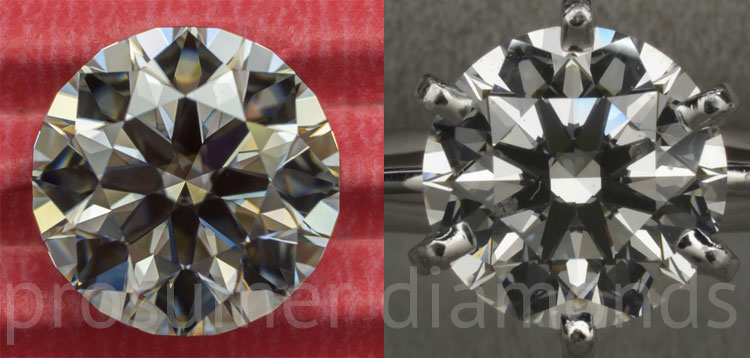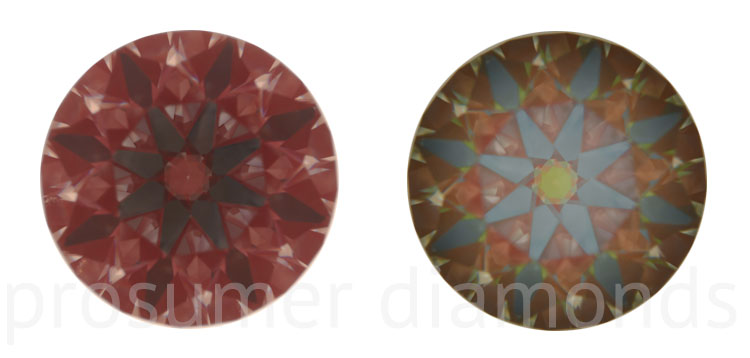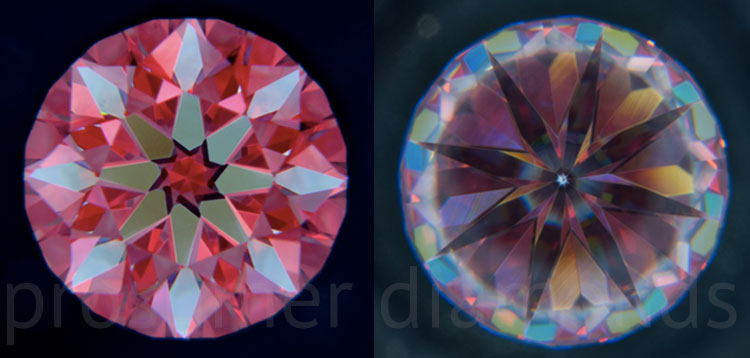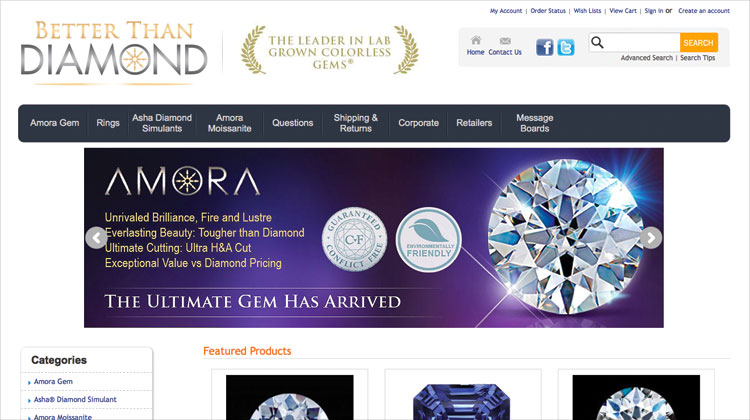
For the past three years, I have followed the development of the Amora Gem Review from BetterthanDiamond (BTD). Every Friday, I would look forward to reading the weekly updates that the President of BTD, Less P. Wright, would blog about. I just wish more CEOs are as engaging with their prospective customers as Less is.The Amora Gem finally became available for sale in August 2013. Unfortunately for many of us, due to a soon-to-expire patent, the Amora Gem won’t be available in many countries until 2015.
Chemically, the Amora Gem is a single-crystal silicon carbide with a Mohs hardness of 9.25 – 9.50. The Amora Gem is at least 27% harder than sapphire based on nanoindentation hardness testing so it’s durable enough to be a forever stone. Also, the Amora Gem is completely colorless in it’s purest form and achieves a D-color on the GIA diamond grading scale.
Since 2014, the Amora Gem has been given an “Ultra H&A” cutting and has since been known as the Amora Gem Ultra. The ‘Ultra’ is the result of BTD’s iterative efforts to maximise the brilliance, fire, and scintillation of the Amora Gem.
The Amora Gem I am reviewing today is an Amora Gem Ultra but I shall be referring to it simply as the Amora Gem.
You should also be aware that the Amora Gem is not the same as the Amora Enhanced Moissanite, which BTD also carries. Moissanite is a different form of silicon carbide with a different chemical structure and optical properties.
Because I had been waiting for such a long time to see the Amora Gem for myself, I was pretty excited when I was given the chance to review the Amora Gem. I wanted to do something different so I decided to make Prosumer Diamond’s first video review to show you the differences in fire and brilliance between the Amora Gem and diamond.
Marketing Material
BTD describes the Amora Gem as the “ultimate gem”, and is the “only lab-grown gem to surpass diamond in toughness, fire, brilliance, and luster.” They specifically claim that the Amora Gem has 10% more brilliance and 200% more fire.
From the video, it’s pretty obvious that BTD’s claims about brilliance and fire are true. This wasn’t surprising at all due to the higher refractive index (2.66-2.71 in Amora Gem vs 2.417 in diamond) and higher dispersion (0.104 in Amora Gem vs 0.044 in diamond). But BTD also mentions that the Amora Gem surpasses diamond in toughness and luster so I want to address these issues first, as these characteristics are not the first things consumers think about when they buy gemstones.
Luster describes how a material shines when it reflects light. The luster of the Amora Gem and diamond can both be described as adamantine. However, in gemstones, luster is proportional to the refractive index so this is why the Amora Gem can be said to have greater luster than diamond. In reality, there’s pretty much no noticeable difference.
Toughness is not a property that is often referred to in gemstones because gemstones are generally not very tough. A tough material is both strong and ductile. For example, steel is strong so it is used in construction and copper is ductile so it can be drawn into wires.
Try not to get confused with the terms toughness and hardness. Although diamond is very hard, it is also fairly brittle (the opposite of being ductile) and cannot be considered tough. In particular, diamonds have cleavage planes that are particularly susceptible to fracture and this is why you might chip a diamond if you bang it against a metal by accident.
The Amora Gem does not have these cleavage planes and with twice the fracture toughness (4 MPa · m1/2 in Amora Gem vs 2MPa · m1/2 in diamond), it can rightly be said to be tougher than diamond. However, you still have to be careful with it because it’s still not very tough when compared to metals.
Certification
The Amora Gem came with a laminated certificate from the North American Gemological Laboratory (NAGL).
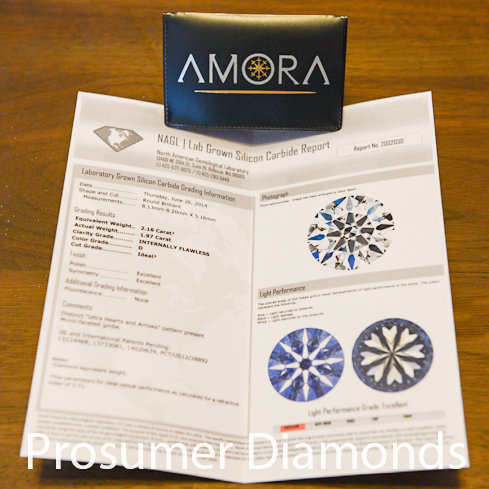
But what you need to know is that the reports from NAGL do not contain the same information that you would find in a GIA report. For example, many of the proportions that are stated on a GIA report are missing in the NAGL report. The NAGL report does however have an actual digital color picture of the Amora Gem and this isn’t something you will find on a GIA report.
My one criticism about the NAGL report is the light performance section. The hearts and arrows images are not the actual images of the Amora Gem and there is nothing in the report that discloses this to the reader.
At first, I was confused because the actual photo of the Amora Gem is right above these light performance images and the actual photo has a remark that states, “Photo approximate. Image has been enlarged to show detail.”
It was only once I did a full analysis on the Amora Gem that I could conclude that the light performance images were not representative of the actual Amora Gem. To me, this potentially misleads consumers to think that all three images are actual enlarged images.
(Note: I spoke to Less about this and he has confirmed that the H&A images are indeed stock photos of an Amora Gem.)
The Analysis
The video comparison at the beginning of this review should give you a pretty good idea of how the Amora Gem performs relative to the other gemstones. But to give you an even better understanding of how the Amora Gem performs in other lighting environments, I’m going to walk you through my evaluation of the Amora Gem.
The first thing I did when I received the Amora Gem was to look at it next to a north-facing window in my living room. This is one of my favourite lighting conditions to view the brilliance of diamonds but I was not prepared for the blinding brilliance that the Amora Gem had. In fact, there was so much brilliance that my eyes had trouble focusing. In comparison, I had my wife’s engagement diamond with me but my eyes had no problems focusing it under the same conditions.
Now one of the quickest ways to tell a CZ from a diamond is to look at it from an angle. At a certain point there will be what is known as windowing where basically you can see right through the stone. This happens because of the lower refractive index of CZ. To check for windowing, I held the Amora Gem between tweezers facing the window and tilted it at an angle. I was happy to see that windowing is not an issue in the Amora Gem.
Next I moved to the center of my living room and turned the Amora Gem away from the window to look at it in more diffuse lighting. The first thing I noticed was the arrows pattern of the Amora Gem jumping out at me.
But even though the arrows pattern in the Amora Gem was clearly visible, I found that the diamond seemed to have more depth to it because the contrast in the Amora Gem was not as strong. Also, in this diffuse lighting, the Amora Gem had a little bit of color to it that the diamond did not have.
I went to a more shaded part of the room to view the gems. The diamond and the Amora Gem reacted similarly here and both appeared duller in the lower lighting environment. The Amora Gem was brighter, but I still preferred the contrast pattern in the diamond.
Impressed with how bright the Amora Gem was, I took it under a single halogen spotlight in my corridor and was blown away by the fire and scintillation. I was happy to see nice big bold flashes of colored fire from the Amora Gem, which I personally prefer over small pin fire flash.
The fire was evenly distributed and had the type of balanced symmetry that I expected. In comparison, the diamond in the same lighting was much less exciting with much fewer events of fire. Honestly my eyes preferred what I was seeing in the Amora Gem.
Close Examination
The gem with the red background is the Amora Gem and the gem with the grey background is the diamond.
In this critical view of the Amora Gem, you can see the subtle differences between this Amora Gem and a hearts and arrows diamond. If you have a keen eye you will notice that the Amora Gem is not as round as the diamond. This is because of the crown-girdle that BTD implemented to improve the light performance of the girdle facets.
I have to say that I’m not a big fan of this crown-girdle, because the Amora Gem I reviewed had some meet point problems. However, Less has assured me that they have already found a solution to this problem.
You can also see that the light return under the table is weak compared to the diamond. The picture of the diamond was taken under different lighting so this is not a comparison of the brightness between the Amora Gem and the diamond. What I want you to look at is the relative brightness in each photo.
You can see that the diamond clearly has more light return under the table facet. Weaker light return isn’t necessarily a bad thing and many super-ideal diamonds have proportions with weaker light return under the table. This is meant to help improve the contrast in the stone and, depending on your preferences, it is fine as long as we don’t see any red that would indicate significant light leakage.
Light Performance
The reason for the weaker light return underneath the table facet is because the Amora Gem is cut deeper than the diamond. The depth of this Amora Gem is around 63% and in a diamond, this would be unacceptably deep. However, part of the depth of the Amora Gem is due to its thick girdle so I don’t expect the pavilion facets to be overly steep.
To be even more critical, here are the idealscope and ASET images of the Amora Gem.
The idealscope is most revealing because it shows that there is actually some light leakage under the table and in the upper girdle facets. But bear in mind that the idealscope is backlit so it enhances the places with weaker light return and light leakage. In reality, the leakage under the table isn’t really noticeable and is basically impossible to detect with the naked eye.
The ASET is most useful for seeing how the Amora Gem handles light. From this ASET image, there’s really nothing that separates the Amora Gem from that of a well-cut diamond except for the double refraction that can be seen quite clearly in the image as two table reflections in the center of the Amora Gem.
The upper girdles are slightly steeper than I would like them to be. You can tell this in the ASET from the M’s at the arrow tips being a little spread apart. But you can actually see the effect of this best in the idealscope as weaker light return in the upper girdles compared to the rest of the Amora Gem.
Hearts and Arrows
BTD tells us that every Amora Gem is cut to the highest hearts and arrows standard. For my interpretation of the hearts and arrows standard, you can read my article on hearts and arrows.
Here are the hearts and arrows images for the Amora Gem.
When we look at the arrows image, what we are looking for are arrow heads that are aligned well with the arrow shafts. But no matter how hard I tried, I couldn’t get the Amora Gem perfectly level to take a good picture so it looks like there is some misalignment in the arrows when it’s really just caused by camera-tilt. This isn’t too important because it is the hearts image that is more reliable when determining optical symmetry.
The hearts image clearly shows that some of the hearts touch the Vs. The reason this happens is because the lower girdle facets have been cut short to give the Amora Gem thicker arrows. However, for H&A purists, this fact alone will disqualify this Amora Gem from being a ‘true’ H&A.
For me, the length of the lower girdles are not the most important, what is important is that the image shows you how optically symmetrical the Amora Gem is. Looking past this ‘flaw’, the Amora Gem has excellent optical symmetry and is well within what I consider to be a good hearts and arrows cut.
Price
This review wouldn’t be complete if I didn’t mention the cost of the Amora Gem. The 2ct DIF Amora Gem in this review had a listed price of $2,265.84 USD.
The same 2ct DIF in a natural diamond would cost over $80,000 USD (and only if you purchase it from a budget online vendor). The Amora Gem works out to be about 2% of the cost of diamond.
For all those young couples struggling financially, sometimes we have to wonder why it’s so important to spend so much money on a diamond. The Amora Gem lets you have that beautiful forever stone without breaking the bank.
If you must have the D-color and Internally Flawless clarity then BTD does charge a premium for this, but I would expect this to come down once they inevitably make improvements to their production processes and the yield for high color and clarity rough increases.
For now, you can get a 1.7ct FVS1 for $1,036.27 USD and in my opinion this is quite reasonable for what you’re getting, especially when you compare it to a $699 price for a 1.5ct Forever Brilliant Moissanite.
One thing you should bear in mind is that the Amora Gem doesn’t have the secondary market that diamond has where you can easily get back 70% of the value of your diamond if you know what you’re doing. This means that if you were to get a $3,500 USD diamond, you’ve only really spent about $1,000 USD. For $3,500 USD, you could get a very respectable 0.90cts ISI1 diamond and this is what you should be comparing when you’re considering getting the 1.7ct FVS1 Amora Gem.
Final Thoughts
I hope that you now have a pretty good idea of how the Amora Gem performs and whether it’s the right gem for you. What I have found is that the bold claims BTD makes seem to hold up even under my most critical examination.
BTD doesn’t market the Amora Gem as a diamond simulant and I can see why they haven’t. It’s just different to a diamond and a beautiful gemstone in it’s own right.
If all you were looking for is a diamond simulant then my recommendation to you is that you’re probably better off purchasing an Asha. But if you’re a gem lover like me, then the Amora Gem really does solve many of the problems I have with other gems.
Diamonds are expensive and lack colourful fire, Moissanites cannot be D to G in color and have a chameleon type behavior, and CZs have windowing, poor proportions, and scratch easily. If the Amora Gem didn’t exhibit double refraction, well, then I’d probably say it would be the perfect gem for me.
When you’re looking for an Amora Gem, try to find one with the smallest difference between the maximum and minimum diameter. I would also try to pick one that is less than 63% deep. If you’re getting a setting made for the Amora Gem, then make sure you give the jeweller the actual dimensions of the Amora Gem and when you’re having it set make sure you remind the jeweller again that they are not working with diamond and that they should treat the Amora Gem as they would a sapphire.
When you buy an Amora Gem, what you’re getting is an affordable, durable forever stone that is cut to hearts and arrows standard and is brighter and more fiery than a diamond. What the Amora Gem won’t be is that it won’t look exactly like a diamond in all scenarios.
So as long as you purchase the Amora Gem with the right expectations, I have no doubt that you’ll be happy with it. For those of you lucky enough to already own one, enjoy it and wear it proudly!
